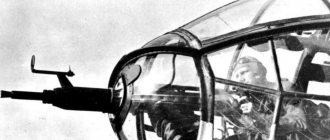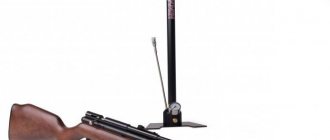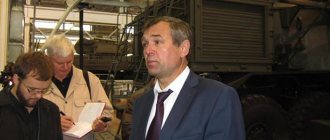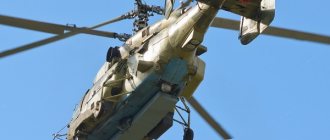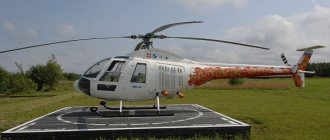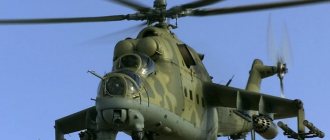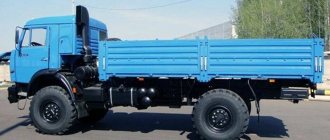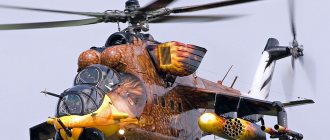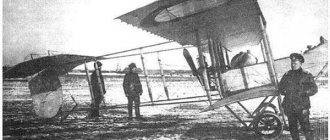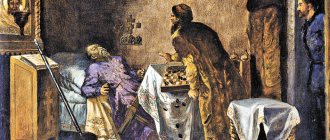Cobra Helicopter The Cobra helicopter (Bell AH-1 Cobra) is an American two-bladed single-engine attack helicopter manufactured by Bell Helicopter. This example used the engine, rotor system and transmission from the Bell UH-1 Iroquois helicopter. This flying vehicle belongs to the Huey family and the helicopter is also known as HueyCobra or Snake. It is the world's first purpose-designed attack helicopter.
The Cobra helicopter was once the main combat helicopter of the US Army, but was later replaced by the AH-64 Apache. Upgraded versions of this helicopter continue to fly today along with other military helicopters from several other countries. Twin-engine Cobra helicopters are still used by the US Marine Corps as their primary attack helicopter. The surplus AN-1 helicopter was converted and is today used to fight forest fires.
The history of the Cobra helicopter
The history of the creation and development of this helicopter is closely connected with the history of the Bell UH-1 Iroquois helicopter in the Vietnam War and one of the most numerous helicopters. The new US tactics required the army to be mobile over a wide area, and the Iroquois helicopter made it a reality. The helicopters were not supposed to engage in long battles or stay in one position for a long time. Everything would be fine, but it soon became clear that the then military helicopters were extremely vulnerable to ground fire from the Viet Cong and North Vietnamese forces, especially at the moment of landing for the release of troops and without the support of artillery or ground forces, the only way to secure the landing zone was with air, and, preferably, a helicopter that would reliably accompany transport helicopters along the path of military operations. By 1962, a small number of military UH-1As, armed with a few machine guns and rocket launchers, were being used as escorts.
Helicopter Cobra
The massive expansion of the American military presence in Vietnam ushered in a new era of air warfare. The mainstay of American Army tactics was helicopters, and protecting those helicopters became vital.
Iroquois Warrior, Sioux Scout and AAFSS
Bell had been studying attack helicopters since the late 1950s and created a mock-up of his D-255 attack helicopter concept called the "Iroquois Warrior". In June 1962, Bell showed the prototype to Army officials, hoping to obtain funding for further development. The Iroquois Warrior was planned as a purpose-built attack aircraft based on UH-1B components with a new slim planetary and two-seat tandem cockpit. It housed a grenade launcher in a ball turret on the nose, a 20-mm machine gun and wings for mounting missiles and SS.10 anti-tank missiles.
The Army became interested in the development and awarded Bell a contract to create the concept in December 1962. Bell modified the Model 47 into the Model 207 Sioux Scout, which first took to the skies in July 1963. The Sioux Scout had all the key features of a modern attack helicopter: a tandem cockpit, wings for mounted weapons and a turret-mounted cannon. After testing the Sioux Scout in early 1964, Army officials were impressed, but at the same time felt that the helicopter was undersized, underpowered, and poorly suited for practical use.
Bell 207 Sioux Scout
The Army's decision about the shortcomings of the Sioux Scout was associated with the launch of the AAFSS (Advanced Airborne Fire Support System) competition. The AAFSS requirement gave rise to the Lockheed AH-56 Cheyenne heavy attack helicopter with high speed capabilities. The helicopter's design proved too complex and the program was canceled in 1972, after ten years of development. The Army has achieved greater survivability in the traditional attack helicopter as well.
Model 209
At the same time, despite the Army's preference for a helicopter over the AAFSS concept, for which Bell's helicopter was not chosen as a competitor, Bell stuck with his idea of a smaller, lighter attack helicopter and invested $1 million in January 1965 to develop new design. Coupled with a proven transmission, a UH-1C "540" type rotor system complemented by a Stability Augmentation System (SCAS), and a T53 UH-1 turboshaft engine with a Sioux Scout design philosophy, Bell released the Model 209, which in many ways resembled the Iroquois Warrior layout. .
Events in Vietnam also moved in favor of the Model 209. Attacks on American troops increased, and by the end of June 1965 there were 50,000 US ground troops in Vietnam. 1965 was also the eligibility deadline for the AAFSS program, but the final outcome will depend on technical difficulties and political disputes. The US Army needed temporary attack helicopters for operations in Vietnam and asked five companies to provide a quick solution to the situation. The variants presented were the Boeing-Vertol ACH-47A, Piasecki 16H Pathfinder, Sikorsky S-61, Kaman HH-2C Tomahawk and Bell 209.
On September 3, 1965, Bell rolled out his prototype Model 209, and four days later it made its first flight, just eight months after the start of construction. In April 1966, the model defeated other competing helicopters. Then the US Armed Forces signed the first contract for the production of 110 aircraft. Bell added the prefix "Cobra" to the name Huey UH-1, resulting in the HueyCobra 209. The Army applied the name "Cobra" to its designation for the AH-1G helicopter.
Over the next six years, the Bell 209 prototype was used to test weapons and equipment. It was modified to the AH-1 production standard by the early 1970s. A test sample was later sent to the Patton Museum at Fort Knox, Kentucky, and was restored as closely as possible to its original appearance.
Primary requirements
Irreversible "Ruslan"
Will Russia be able to resume production of the An-124 aircraft?
As sources in the military-industrial complex and the military department told Izvestia, the tactical and technical requirements for a promising military transport aircraft have already been approved. The vehicle should replace the heavy An-124 and An-22.
Currently, research work (R&D) has been opened to determine the characteristics of the Advanced Aviation Complex of Military Transport Aviation (PAK VTA). The creation of its preliminary project was entrusted to PJSC Il, sources in the military department and the military-industrial complex told Izvestia. According to the plan, it must be prepared by December 2020. In 2021, it is planned to begin the next stage - development work (R&D). Ilyushin has already spent at least 250 million rubles on determining the parameters of a promising aircraft and creating its preliminary design.
The tactical and technical requirements for research (available to Izvestia) indicate the mandatory requirements that the Ministry of Defense has put forward for the new aircraft.
An_1
Military transport aircraft An-22 "Antey" of the Russian Aerospace Forces at Tolmachevo airport
Photo: RIA Novosti/Alexander Kryazhev
One of the most unusual is the ability to refuel in flight from air tankers. Previously, such technology has not been used for large military transport aircraft in our country. The new aircraft must transport at least 80 tons of cargo over a range of 5 thousand km. The length of its cargo compartment will be at least 27.5 m. The width and height will be 5.8 and 4.4 m, respectively.
Titans of the air: MS-21 airliners will be able to fly three times longer
Scientists have created a super-strong alloy for domestic aircraft engines
PAK VTA will be equipped with four turbojet engines with a thrust of 20–25 thousand kgf. They will give the aircraft the ability to fly at altitudes of up to 12 km and a cruising speed of 850 km/h. Russia has yet to create such an aircraft engine. The documentation indicates the promising PD-35, which is currently being developed, as a contender.
The preliminary design also requires taking into account the possibility of basing the VTA PAK on unpaved and snowy airfields. All modern aircraft of the domestic military transport aviation are capable of this.
“The military department has developed requirements for the future aircraft based on its needs and tasks,” ex-commander of the 4th Air Force and Air Defense Army, Lieutenant General Valery Gorbenko, told Izvestia. “It must transport cargo over long distances, carry out landings and do without airfields with concrete pavement. It will be a wonderful car if it is made like this.
The carrying capacity and dimensions of the promising aircraft will allow it to parachute out several infantry fighting vehicles at a time, the general added.
“Perhaps the new aircraft will also transport heavy equipment, in particular tanks or tactical missile systems,” noted Valery Gorbenko. — The result will be a multi-purpose machine capable of performing a wide range of tasks. Let's hope that in a few years the promising aircraft will appear in the army.
An_2
A serviceman watches the landing of the An-124-100 "Ruslan" military transport aircraft of the Russian Aerospace Forces at the Koltsovo airfield
Photo: RIA Novosti/Pavel Lisitsyn
The Ministry of Defense has set the task of developing a vehicle capable of transporting all possible weapons and equipment that are generally intended for transportation by air. The terms of reference indicate not only the equipment of the Ground Forces. The VTA PAK must take on board helicopters and aircraft, including MiG-31BM fighters, air defense systems and radars of the Radio Technical Troops. And also provide airborne drops.
The Russian Federation has begun designing a promising military transport aircraft
The terms of reference require that the company's previous development work be taken into account when creating the preliminary design of the PAK VTA. Among them are R&D projects for the creation of the M-60 military transport aircraft, the Il-78M-90A air tanker and the modified An-124-100M heavy transport aircraft.
Once the research work is completed by the end of this year, it will be possible to move on to the stage of development work. During this period, the design and construction of prototypes will begin. For this purpose, a new government contract will be concluded.
Production of the Cobra helicopter
The body of the Cobra helicopter was modified for mass production. The retractable skids have been replaced by simpler fixed ones. A new wideband rotor was used. To produce the plexiglass canopy, the armored glass canopy 209 was replaced, which was quite heavy and impaired efficiency. Other changes were included after service began. The main one was to move the tail rotor from the left side of the helicopter to the right to improve operating efficiency.
Bell AH-1G Cobra
The US Marine Corps was interested in the Cobra and ordered an improved twin-engine version in 1968 under the designation AH-1J. This led to the creation of twin-engine variants. In 1972, the Army sought to improve anti-armor capabilities. The Enhanced Cobra Weapons Program (ICAP) tested eight AH-1 helicopters equipped with TOW anti-tank missiles in October 1973. Following qualification testing the following year, Bell was contracted to upgrade 101 AH-1Gs to TOW-compatible AH-1Qs. Following operational testing on the AH-1Q, a more powerful T53 engine and transmission was added from 1976, resulting in the AH-1S version. The AH-1S helicopter was modernized in three stages, culminating with the appearance of the AH-1F model.
History of application
US Armed Forces
By June 1967, the first examples of the AH-1G HughCobra were delivered. Originally designated the UH-1H, the "A" was soon adopted as the attack helicopter, and when the improved UH-1D became the UH-1H, the HughCobra became the AH-1G. The AH-1 was initially considered as a variant of the H-1 line, resulting in the G series letter.
AH-1 Cobras were used by the Army during the Tet Offensive (General Offensive and Tet Mau Than Uprising) in 1968 until the end of the Vietnam War. Cobras provided fire support for ground forces, escorted transport helicopters, and performed other roles, including aviation rocket artillery (ARA) battalions in two airmobile divisions. They also formed "killer hunter" teams, teaming up with OH-6A reconnaissance helicopters. This teaming saw a single OH-6 flying slow and low to find enemy forces. If fire is opened on the OH-6, the Cobra can strike an exposed enemy. On September 12, 1968, Captain Ronald Fogleman was flying an F-100 fighter when the plane was shot down and the pilot ejected 200 miles north of Bien Hoa. Ronald became the first and only rescued pilot to escape in an AH-1G military Cobra helicopter while holding onto the deployed gun turret door. Bell built 1,116 AH-1Gs for the US Army between 1967 and 1973, and all Cobras logged more than a million combat hours in Vietnam, with 1,081 helicopters in service. Of the nearly 1,110 AH-1s delivered from 1967 to 1973, about 300 saw combat and wartime accidents. The US Marine Corps used the AH-1G Cobra in Vietnam for only a short time before acquiring the twin-engine AH-1J Corks.
AH-1T Cobras were deployed for the 1983 invasion of Grenada ("Flash of Fury"). During close support flights and helicopter escort, two of the four units were lost to anti-aircraft fire while attacking Fort Frederick. The Cobra Army participated in Operation Just Cause during the 1989 US invasion of Panama.
During Operations Desert Shield and Desert Storm in the Persian Gulf War (1990-1991), Cobras and SuperCobras were deployed in support roles. The US Marine Corps has deployed 91 AH-1W SuperCobras and 140 AH-1s of various models; they operated from forward, scattered desert bases. Three AH-1s were lost during and after the fighting. Cobras destroyed many Iraqi armored vehicles and various targets in the combat zone.
Cobra helicopters supported the US humanitarian intervention during Operation Restore Hope in Somalia in 1993. They were also used during the 1994 US invasion of Haiti. American Cobras were also used in operations later in the 90s
The US Army retired the AH-1 in the 1990s and withdrew the AH-1 from service in March 1999, offering them to NATO allies. The AH-1 was retired from reserves in September 2001. retired AH-1s were transferred to other countries and the USDA Forest Service. But the AH-1 continues to work with the American military, the US Marine Corps in the form of the twin-engine AH-1W SuperCobra and AH-1Z Viper.
Israel
The Israeli Air Force named its Cobra "Zepha" (from Hebrew - Viper). Since the mid-1970s, Lebanon has been Israel's most active frontline; The Israeli Air Force's Cobras fought there for more than 20 years.
Bell AH-1S Tzefa
Cobra helicopters were also used extensively by the Israeli Air Force in the 1982 Lebanon War to destroy Syrian weapons and fortifications. Israeli Air Force Cobras destroyed dozens of Syrian ground vehicles. Cobras were also used in major operations against Hezbollah in Operations Responsibility and Operation Grapes of Wrath in southern Lebanon.
At the end of 2013, Israel retired 33 AH-1 units due to budget cuts. The attack helicopter role has been completely replaced by squadrons of Israeli AH-64 Apache helicopters, and a fleet of unmanned aerial vehicles (UAVs) has taken over the role of patrolling combat zones. The Cobra fleet was older than the Apaches, which contributed to some fatal accidents. Cobras were more expensive than UAVs and were subject to attacks from man-portable air defense systems operated by guerrilla forces. In late 2014, Israel transferred 16 Cobras to the Royal Jordanian Air Force to add to its existing fleet for border security in response to threats from Islamic militants or other insurgent groups.
Japan
Japan produced 89 of its own AH-1S Cobras under license from Fuji Heavy Industries from 1984 to 2000. This type is used by the Japanese Ground Self-Defense Force and is the 3rd generation of helicopters that are roughly equivalent to the US Army AH-1Fs. This model has a T53-K-703 turboshaft engine, which was licensed by Kawasaki Heavy Industries.
Jordan
Jordan received 24 AH-1Fs in the late 1980s and received nine additional US Army helicopters in 2001. In 2010, Jordan transferred 16 AH-1F helicopters to Pakistan as part of a US-led support program that provided Islamabad with 40 refurbished AH-1 helicopters.
The Royal Jordanian Air Force has at least one squadron of Cobras in service today and is expected to use them in combat in Iraq and Syria.
Türkiye
In the early 1990s, Turkey bought ten AH-1Ws and supplemented them with 32 retired American Cobras. These were several TAH-1P trainers, and the rest were upgraded to the AH-1F model. Turkish Cobras have seen combat against Kurdish rebels near the Iraqi border. Some were lost in these operations.
Helicopter AH-1W Super Cobra
Pakistan
Between 1984 and 1986, Pakistan delivered 20 AH-1S attack helicopters, which were subsequently upgraded with the C-NITE thermal imaging package. Pakistani airpower first used the Cobra in Somalia during UN Operation Somalia 2, where one squadron was sent in 1994. Pakistani Cobras later conducted combat operations in Sierra Leone.
In 2015, Pakistan had 35 AH-1F helicopters in service. Maintaining these aircraft was difficult, but possible through commercial channels. In addition, the US government has provided US$750,000 through 2013 to upgrade Pakistan Air Force's existing AH-1F/S Cobra fleet. Türkiye also supplied spare parts of these helicopters to Pakistan free of charge. Pakistan has lost three helicopters in the last decade.
Pakistan has repeatedly sought opportunities to complement and replace its current AH-1s with the US-sourced Bell AH-1 SuperCobra. Attempts to acquire the AH-1Z Viper or AH-64 Apache from the US were rejected, so Pakistan turned to purchasing other foreign attack helicopters. Possible candidates were the Turkish T129, the Chinese CAIC Z-10 and the Russian Mi-35 M. In November 2014, Russia approved the sale of Mi-35M helicopters to Pakistan. In April 2015, China transferred three Z-10s to Pakistan. That same month, the US State Department approved the sale of 15 AH-1Zs and associated equipment to Pakistan. As of October 2022, the T129 was also a contender.
US fire protection system
In 2003, the US Forest Service purchased 25 retired US Army AH-1Fs. These were designated Bell 209 and are converted to Cobras Firewatch with infrared and low light sensors for real-time fire monitoring.
The Florida Forestry Division also acquired three USAF AH-1Ps. They are called Bell 209 "Firesnakes" and are equipped with water transfer systems to combat fire.
shTTEYRKHBMNE HYAONKEGNBUMHE BEPRNKERNB B yNPEE ONPNDHKN BN BYAEL LHPE MUYARNYKHI BEPRNKERMSHI ASL. xGLEMHKHYAE X BGTSKDSH BNEMMSHU MU PNKE BKHMRNYPSHKSHU LYUHM B BNNPSFEMMSHU YAHKYUU. YNKKHVEYARBN GUYSOYUELSHU BEPRNKERNB PEGYN BNGPNYAKN, MN NAKYUYARE KH OPHLEMEMKH ONVRKH ME KHGLEMKHKYUYAE: RPYUMYAONPRKHPNBYU YANKDYUR H TsPSGNB, ONKHYAYNBN-YAOYUYUREKEMSHE NOPEYUZH XX X I VERNL NOSHRYU BNIMSH B yNPEE, NOKHPYYAE MU YNMYARPSYZHCH SDUVMNI LYUHMSH "LNDEKE 47", MU THPLE "aEKK" PYUGPYUANRYUKH UH-1 - GMULEMHRSHI "UECH", YNRNPNLS YASFDEMN ASHKN YAR JRE "NRZHNL" OEPBNTsN B LHPE YAOEZHHYUKHGKHPNBYUMMNTSN BEPRNKERYU-URSPLNBKHYU. bNNPSFEMMYU LNDEKE "UECH" - UH-1C ONKSVHKYUYAE DNBNKEMN SDYuVMNI. MN BYAE-RUYKH SHRN ASHKYU OEPEDEKYU RPYUMYAONPRMNI LYUHMSH. KERVKHY KHLEK NTSPYUMKHVEMMSHI NAGNP, TsPSGNBUYU YUAHMYU ASHKYU ЪBMN KHMEI, DU KH KERMSHE UYUPYUREPHYARKHYKH NYARYUBKKKH FEKURE KSVIETSN. tKhPLYU MY YABNI YARPYUU H PKHYAY, AEG ONDDEPFYH BNEMMSHU MYUVYUKYU PYUGPYUANRYS YAOEZHHYUKHGHPNBYUMMNTSN ANEBNTSN BEPRNKERYU. YNLONMS OPKHMZHHOKHYUKEMN MNBSHI BEPRNKER, PYUGPYUANRVKHYKH, VRN MYUGSHBUERYA, ONOYUKH B KOKNVYN. dBYU VKEMYU SHYKHOYUFYU PYYAONKYUTSYUKHYAE RYUMDELNL, YARPEKNYY - MU OEPEDMEL YAKHDEMEE, KERVKHY - MU GYUDMEL. sGYKHI TCHGEKЪF YAN YARPEKINBSHL BNNPSFEMHEL B OEEDMEI VYUYARKH, YPSHKN MEANKENTSN PYUGLYUYUYU, - BYE SHHRKH REUMHVEYAYHE PEYEMKH MU DNATSKHE TsNDSH NOPEDEKKHKH NAKKHY ANEBSHU BEPRNKERNB B N LMNTSKHU YARPUMYUU. kKHE ONEBKEMKHE PNYYAKHIYAYNTSN yu-50 BHDNKHGLEMKHKN BMEMKHI BHD ANEBNTSN BEPRNKERYU.dKЪ SHYNMNLHH BPELEMKH OPH PUGPYUANRYE DELNMYARPYUZHNMMNTSN NAPYUGZHYU HYAONKEGNBUKHYAE DHMYULHVEYAYHE YAHYARELSH BEPRNKERYU "aEKK" 47. lNDEKE 207 "YAHSYA YAYUSR" OPNUNDHKYU YANBLEYARMSHE I YUPLHEI yay KERMSHE HYAOSHRYUMKH B tNPR-aEMMKHMTSE B YOOPEKE 1963-CN. хЯОШРУМХЪ OPNNKH SYAOEMN, UNRЪ BNEMMSHE NRLERHKH YAKYUANYARE BNNPSFEMKH (2×7.62 LL OSKELERYU MU ONDBHFMNI RSPEKH) X MENAUNDHLNYARE GYULEMSH ONPMEBNTSN DBKHTSUREK TSYUG NRSPAHMMSHL. хЯОШРУМХЪ "YAHSYA YAYUSRYU" ONDRNKYMSKH YUPLHCH yayu Y NAZBKEMHCH YNMYSPYAYU MU PYUGPYUANRYS SYANBEPEMYARBNBUMMNI YAHYARELSH NTSMEBNI ONDDEPPHYH AAFSS. TYUBNPHRNL ShchRNI OPNTsPYULLSH YARYUK BKHMRNYPSHK THPLSH “KNYUKHD” YAH-56 “YUIEM”. yu ONYU BKH MYUSVMN-HYAYAKEDNBUREKEYAYHE X NOSHRMN-YNMYARPSYRNPYAYHE PUANRSH ON “yuIEMS”, GYUDYUVH ON NTSMEBNI ONDDEPFYE YASUNOSRMSHU BNIYAY BNGKNFHKH MU BNNPSFEMMSHI “UECH” - U H-1ya. sLMSH TSNKNBSH KH THPLSH "aEKK" ONGBNKHKH SYANLMHREYA B OPYUBKHKEMNYARKH RUYNTSN PEEMKH. "YUIEM" ASHK NVEME YAKNFMSHL KHDEKHEL I ANKENNI YAREOEMECH REUMKHVEYAYNTSN PKHYAYU, X MU YAYNPNE ONYARSOKEMHE ETSN B BNIYAYU PYYAYAVKHRSHBYURE ME OPHUNDHKNYAE, Yu UH-1C X OH NTSMEBNI LNYH, X OH KERMSHL UYUPYUREPHYARKHYUL ЪБМН ME DNRЪTSKHBYUK DN ONKMNZHEMMNTSN ANEBNTSN BEPRNKERYU. MUOPYUKHBUKYA BSHBND: DEKURE OPNLEFSRNVMSHI BYUPHYUMR, LYUYAKHLYUKEMN HYAONKEGS UNPNN NRPYUANRYUMMSHE SGKSH X YAKHYARELSH "UECH". fHGME ONYUGYUKYU OPYUBHKEMNYARE RUYNTSN ONDUNDU. oEPBSHE OPKHYKHDIKH ON "OPNLEFSRRNVMNLS" ANEBBNLS BEPRNKERS ASHKH TsNRNBSH B YUBTSSYARE 1963-CN. b SCHRNL FE LEYAZHE MYVYUKHYAE ANEBSE DEYARBHJ BN BEERMULE. b DFSMTSKU PYUGBEPMSKYUYAE MUYARNYYYU BEPRNKERMYU BNIMYU. nYAMNBMSCH MYUTSPSGYS MEYAKH PYUGKHVMSHE LNDKHTKHYUZHKH "UECH". bePRNKERSH BSHYUFKHBUKH DEYYUMRSH, BEKH PUGBEDYS, OEPEBNGHKH TsPSGSH, ONDEPFKHBUKH NTsMEL BNIYAYU. rSR-RN X OPNЪBKHKHYAE MEDNYARYURYKH UH-1C YUY OKYURTNPLSH DK PUGLEYEMH NPSFKH. b oEMRYUTSNME BSHBNDSH YADEKYUKH ASHIARPN, KH B DEYYUAPE 1964-TSN I THPLNI "aEKK" ASHK GUYKCHVEM YNMRPUYR MU PUGPUANRYS B REVEMHE LEYARKH LEYAZHEB ANEBNTSN BEPRNKERYU I LUYAYANI OSYAR NTsN 3270 YTS X LYUYAHLYUKEMNI YAYNPNYARECH 370 YL/V.
nR MYUVYUKYU PYUGPYUANRYKH DN BSHYYURYKH OEPBNTSN NOSHRMNTSN BEPRNKERYU OPNKN LEYARE LEYAZHEB, YUY H NTSNBUPHBUKNYAE YNMRPUYRNL I YUPLHEI yayu. b YAEMRIAPE ET-OKHKNR THPLSH "aEKK" aHKK ySKHMKShchM BOEPBSHE ONDMYK BEPRNKER B BNGDSU, ONKSVKHBHI NANGMYUVEMKHE UH-1H - NVEPEDMYU LNDKHTHYUZHKH "uECH". MN BYAINPE YNLYUMDNBYUMKHE YUPLXX yayu BSHDEKHKN MNBSHY YKYUYAYA BEPRNKERNB - SDYUPMSHE (attack), X UH-1H YANTSKYUYAMN SHRNI YKYUYAYAHTHYUZHHH YARYUK KHLEMNBUREYA AH-1G
(Attac Helicopter - 1 Gunship), YU MENTHZHYUKEMN - “UECH yNAPU”. yaRNKE YNPNRYKHI JAPNY PUGPYUANRYKH "yNAPSH" NAZYAMYERYA LYUYAHLYUKEMN BNGLNFMSHL HYAONKEGNBYUMHEL OPNBEPEMMSHU YNMYARPSYRNPYAYKHU PEYEMKHI UNPNN NYABNEMMNTSN UH-1. bMEME AH-1G PYUDKHYUKEMN NRKHVYUERYA NR YABNETSN OPYUPNDHREK UH-1B. REL ME LEMEE, YANUPYUMHKKHYAE DBHTSUREKEMYU SYARYUMNBYU, RPYUMYALHYAYAH KH UBNYARNBYU AYUKYU. lHMHLYUKEMSHE HGLEMEMH OPEREPOEK MEYASYKHI BKHMR (mb): MU YNMZHEBSHU VYUYARU KNOYUYAREI OPHLEMHKH ANKEE YAYNPNYARMSHE OPNTHKH X SAPYUKH YARYUAHKHGHPSCHYHE YAREPFMKH, UYUPYUREPM SHE DK PUMMKHU LNDEKEY AEKKNBAYKHU BEPRNKERNB. IYULYU FE YNMYARPSYZHKH ONKSFEYARYNTSN DBSUKNOYUMNTSN BKHMRYU, KHLECHYETSN BRSKYS I NAYHL TsNPKHGNMRYUKEMSHL KH NYAEBSHLH YUPMKHPYULH RHOYU "DBEPMYU OERK", ME KHGLEMKHKYUYAE . gyURN OEPEDMCHCH VYUARE TCHGEKKFYU YAOPNEYRKHPPNBUKH GYUMNBN. oPH EE PUGPYUANRYE B ONKMNI LEPE SVKH NOSHR YANGDIUMKH "sNPPHEPYU" KH "YAHSYA YAYUSRYU". YARPEKYU X KERVKHYU PUYAONKNFHKH DPSTS GYU DPSTSNL B SGYNI YUAHME I OPEYPUYAMSHL NAGNPNL. b PEGSKERYURE bHPHMS TCHGEKFYU DNBEKH DN 90 YAL. YAMKHFEMKHE KNANBNTSN YANOPNRKHBKEMKH ONGBNKKHKN OPH RNL FE DBKHTSYUREKE, VRN H S "uECH", SBEKHVKHRE LYUYAKHLYUKEMSCH YAYNPNYARE, UNR LYUYAYU OSYARNTSN BEPRNKERYU BNGPNYAKYU.
ON GYULSHYAKS YNMYARPSYRNPNNB, SOPYUBKЪRE BEPRNKERNL LNTSKKH KERVKHY, KH YARPEKNY. RUINE PEYEMKHE ONPNDHKN NOPEDEKEMMSHE OPNAKELSH, ONYAINKEIS B OEPEDMEI YUAHME NYAMNBMNE LEYARN GYUMKHLUKH OPHZHEK KH NPTSYUMSH SOPIUBKEMKH BNNPSFEMHEL. oPHKNYAE ZHEMRPYUKEMSHI PSHVYUTS ZHYKHVEYAYNTSN YUTSIU GYULEMHRE MU PUYAONKNFEMSCH YAOPYUBYU YNPNRYSCH ANINBSCH PSYNRYS. MU NOSHRMNL X OEPBSHU YAEPKHIMSHU BEPRNKERYU HYAONKEGNBUKHYAE OPKHZHEKSH MU OYUMRNTSPYUTYUU, GYUREL HU LEYARYU B ZHEMRPE YUAHMSH GYUMK TSPNLNGDYKHI TSKHPNYARYUAHKHKHPNBUMMSH AND LNMNYSKPMSHI NORHVEYAYKHI OPHZHEK. b UNDE OEPESVKHBYUMKH KERVKHYKH ASHYARPN NYABYUKHBYUKKHYAE I ANYNBNI PSYNRYNI KH NYNASHU MESDNAYARB ME HYAOSHRSHBYUKH, REL ANKEE, VRN SOPYUBKRE BEPRNKERNL HG OPEDMEI YUAHMSH YAKSV YUKNYAE MEVYUYARN. YAHYARELYU SOYUBKEMKH - MENAPIURKHLYU ASYAREPMYU, I DBSYPURMSHL PEGEPBKHPPNBUMHEL. b YAPEDMEI VYUYARKH TCHGEKKFYU SYARYUMNBKEMN YPSHKN LYUKNTSN SDKHMEMKH, PYUGTSPSFYUCHYKHE MB I SGKYULH ONDBEYAYKH YALEMMNTSN BNNPSFEMKH. mu NOSHRMNI "yNAPE" KHLEKNYAE SAKHPYUELNE KSHFMNE YUYAYAKH (YAKSVIUI VPEGBSHVIUMN PEDYKHI, EYAKKH ME EDHMYARBEMMSHY, B KHYARNPKHH BEPRNKERNYARPNEMKH).
KERMSHE HYAOSHRYUMKH "YNAPSH" ONYUGYUKH, VRN SANPYU YUYAYAH KHYE MEGMYUVHREKEMN SKSVIUER KERMSHE UYUPYUREPHYARKHYKH, GURN SYAKNFMYER H SRJFEKER LYUHMS. mu ONYAKEDSCHYHU "yNAPYUU" SYARYUMYUBKHBYUKNYAE MESAKHPYUELNE KSHFMNE YUYAYAKH, YUY S "UECH". rSPANBUKEMSHI DBKHTSYUREKE "KYUIYNLHMTs" T53-L13 PUGBKHBUK LNYMNYARE 1400 K.Ya., MN EE ONKMNNYARECH OPEDYURE MU mb ASKN MEBNGLNFMN, ONYAINKEYS RPYUMYALHYAYAKH NAEYAOEVKHB YUKYU OEPEDUWS RNKAINE 1100 K.Y. dK SLEMEEMKH KHMTPYYYYAMNTSN KHGKSVEMKH YANOKN GUYKCHVHKH B YNFSU, B YNRNPNL BNGDSU YALEKHBUKYA I BSHUKNOMSHLH TSYUGYULH. MU BUNDE BNGDSUNGYUANPMKHYNB DBKHTSYUREK SYARYUMNBHKH THKERPSH RBEPDSHU VYUYARKHZH. NYAMNBMSHL, URURMSHL BNNPSFEMKHEL NOSHRMNI "yNAPSH" ASHK EYARKHYARBNKEMSHI OSKELER "lKHMKHTSYUM" BKHMRNBNVMNTSN YUKHAPYU MU ONDTCHGEKQFMNI RSPEKH. pYUGLEYEMKHE YARPEKYNBNI RNVYKH ASHKN SDYUVMSHL, YU BNR I RNVYKH GPEMHЪ BEYAYU YAYESMDMNTSN GYUKOYU SHRN ASHK YUTS MUGYUD OH YAPYUBMEMHCH I UH-1C, YNRNPSHI B ANEBNI YNMTHTSSPYUZHHH BN NPSFYUKYA DBSL OSKELERYULH (B RNL VHYAKE X YPSOMNYUKHAEPMSHLH) X NDMHL 40-LL YUBRNLYURHVEYAYHL TSPUYURNLERNL. oPUBDU, YARPEKYNBUYU RNVIU AH-1 HLEKYU ANKEKHE STSKSH NAYARPEKYU, MN NDMNTsN OSKELERYU ASHKN ЪBMN MEDNYARYURNVMN. NOHPYUYAE MU RSPEKE ryur-102yu, SYARYUMNBKEMMSCH MU NOSHRMNL BEPRNKERE, THPLYU MYVYUKYU PUGPYUANRYS SMKHTHZHPNBUMMNI RSPEKH st.-28 B RPEU BYUPHYUMRYUU: I DBSL LEYARKHYARB NKEMSHHLH 7.62-LL OSKELERYULH, I DBSL 40-LL YUBRNLYURHVEYAYHLH TSPUYURNLLERYULH X YNLAKHMHPNBYUMMSCH I LEYARKHYARBNKEMSHL OSKELERNL X 40-LL TsPYYURNLERNL. aNEGYUOYUYANYARYUBKK 4000 OYURPNMNB Y YUFDNLS OSKELERS X 321 CPYUMURS. sTsKSH NAYARPEKYU RSPEKH ASHKH 230 CPYUD, ON YUGHLSR X NR +21 CPYUD, DN -50 CPYUD, ON STKSKS LEYARYU. schKEIRPNMMMYU YAHYARELYU BSHVHYAKKYU STSKSH OPKHZHEKHBYUMH I ONOPYUBYNI MU OYUPYUKKYUYA X YUBRNLYURHVEYAYH NRYAKEFKHBUKYU OEPELEYEMHE BEPRNKERYU NRMNYAHREKEMN ZHEKH.
"UECH YNAPU" YANGDUBUKYUYAE OPHLEMHREKEMN Y DEYARBKHL B chTsN-bNYARNVMNI YUGKHH. bNNPSFEMMSHE YAKSH TSNYASDYUPYARB SCHRNTSN PETSKHNMYU KHLEKH DNBNKEMN MEGMYUVHREKEMNE YNKKHVEYARBN APNMEREUMKHYKH, ONSHRNLS YANGDUREKH BEPRNKERYU ME YARYUKH NYANAN LSDPHRE I ONDBEYAMSH L BNNPSFEMHEL, DU X BPEL ONDFHLYUKN: MNBSCH LYUHMS I MEREPOEMHEL FDYUKH BN BEERMULE. MU NOSHRMNL BEPRNKERE, MU YPSHKE ASHKN BYAETSN DBYU SGKYU ONDBEYAYKH, MU YAEPHIMSHU LYUHMYU - VERSHPE. onDBEYAMNE BNNPSFEMHE BYKCHVYUKN AKNYH myup DBSU RHONB, YNMREIMEPSH st. 18 I 7.62-LL OSKELERYULH H I YUBRNLYURHVEYAYHLH 40-LL TSPUMYURNLERYULH st-13 (B YUFDNL YNMREIME PE ON NDMNLS TSPUMYURNLERS I ANEGUOYUYANL 300 CPYUMYUR), YYUYAYERSH I LHMYULH st.-3, DSHLNBSHE YUBHYUZHNMMSHE OPKHANPSH e39p1 X RNOKHBMSH AYUYH ELINYARECH ON 264 K. dK OPHLEMEMH BN BEERMULE ASHKN OPEDKNFEMN RPH RHONBSHU BYUPHYUMRYU ANEBNI MYUTSPSGYH MU BMEMEI ONDBE YAYE. KETSYKHI - 2 AKNYU mup st. 157 I 7 PUYERYULH YUKHAPYU 70 LL YUFDSHI MU MYUPSFMSHU SGKYU ONDBEYAYKH X 2 YNMREIMEPYU st. 18 I NDMHL 7.62-LL OSKELERNL (ANEGYUOYUYA 1500 OYURPNMNB) - MU BMSRPEMMKHU. yaPEDMKHI - 4 AKNYU mup st.-159 OH 19 PUYER YUKHAPYU 70 LL B YUFDNL. rЪFEKSHI - 2 AKNYU mup st-159 MU MYUPSFMSHU SGKYU ONDBEYAYKH 2 YNMREIMEPYU st-18 I NDMHL 7.62-LL OSKELERNL (ANEGYUOYUYA 3000) OYURPNMNB - MU BMSRPEMMKHU. YARPEKNYI OEPEDMETSN YPEYAKYU SOPIUBKK NTSmel ONDBHFMNTSN BNPSFEMH, PYUGLEYEMMNTSN MU RSPEKH, YU KERVKHY OPHLEMK NPSFHE, ONDBEEMMNE MU YPSHKEEBSHU OHKNMYUU. YAKHYARELYU SOPYUBKEMKH NPSFHEL ONGBNKKYU GYUDYUBURE YNKKHVEYARBN NDMNBPELEMMN BSHOSYAYUELSHU OYUP PUYER HG KEBSHU X OPYUBSHU AKNYNB B GUKOYE X KHMREPBYUK LEFDS GYUKOYULH. mup BSHOSYAYUKHYAE RNEAIN YAHLLERPHVMN XG AKNYNB, ONDBEEMMSHU OND KEBSHL X OPYUBSHL YPSHKELH, ONYAINKEYS YYAHLERPHVMSHI OSYAY PUYER OPHBNDHK Y ONEBKEMHCH BNGLSY YUCHYETSN LNLEMRYU KH GYURPSDMK SOPYUBKEMKHE BEPRNKERNL. b YAKSVYUE MENAUNDHLNYARKH KERVKHY LNTs SOPYUBKЪRE NTsMEL BNNPSFEMKH, SYARYUMNBKEMMNTSN MU RSPEKH, YNRNPYU B SCHRNL YAKSVUE FEYARYN THYYAKHPNBUKYUYAE NRMNYAHREKEMN OPNDNKEMNI NYAH BEPRNKERYU, YU YARPEKNYY - OSYAYURE mupSh.
rPYUMYALHYAYAKH, YNLOPEYAYANNP DBKHTSUREK KH YYUAHMYU SHYHOYUFYU ASHKKH OPKHYPSHRSH APNMEOCHRULKH NAYHL BEYANL 122 YTS. BONYAKEDYARBHH, YNTsDU "YNAPU" YARYUKYU KHGBEYARMNI BN BYAEL LHPE, LMNCHE SHYAOPRSH I MEDNSLEMKHEL NRLEVYUKH NRYASRYARBHE APNMEYAREINK YYUAKHMSH SHCHYHOYUFYU, VRN NAZYAMERYA MED NYARYURYNL YARYURHYARKHYH OH GNMYUL ONPUFEMKH BEPRNKERYU I GELKH. ONYAVKHRYUKH, VRN DNYARYURNVMN OPKHYPSHRE OKHKNRNB ANYNBSHLH APNMEOKHRYULH X BSHDBHFMSHLH DN SPNBM OKEV APNMEYKHRYULH. BEERMYULAYKHI NOSHR ONYUGYUK NYKHANVMNYARE RUYNTSN BGTSKJUDYU, KH MU ONYAKEDSCHYKHU BYUPKHYUMRYU "UECH YNAPSH" ONBHKHYAE APNMEYAREIKYU. rNOKKHBMSHE AYUYKH - OPNREIRKHPNBUMMSHE, SARNIVKHBSHE Y ONOYUDYUMKHCH OSKE YUKHAPIU 12.7 LL. bYAE FE TSKYUBMNI GYUYHRNI BEPRNKERYU YAVHRYUKHYAE ETSN LYUKSHE TSYUAYUPHRSH. oPH BGTSKЪDE MU METSN YAMKHGS, I ONGKHZHKH BPYUFEYAYNTSN YARPEKYU, OKNYYUDE OKYUMNBNI OPNEIZHKH ASHKYU RYUNI FE, YUY S YUMTSKKHIYYYNTSN OPEDBNEMMNTSN AHOKYUMVKHYU ╚DE USCHBHK KEMD╩ ╚rYuICEP LNR╩. mYUPЪDS I "yNAPNI" ANEBSHE BEPRNKERSH DEKYUKH KH DPSTSKHE YLEPHYUMYAYHE THPLSH. "OYAEZHYKHI" OPEDCNFHKYU 16m-1yu "oYUYATUIMDEP" - DNBNKEMN MENASHVMSHI KERYUREKEMSHI YOOYUPYUR I RNKYUCHYHL BKHMRNL B YNKEZHEBNL NAREYUREKE MU UBNYARNBNI AYUKYE, "aNKHMTs-b EPRNA" - LNDKHTHYUZHCH "vKHMSYU", "YYULUM" - BNNPSFEMMSHI BYUPKHYUMR LNPYAYNTSN ONKHYAINBN-YAOYUYUREKEMNTSN BEPRNKERYU UH-2 “YAH YAOPYUR”, “YAHYNPYAYKHI” OPEDKNFHK S-61 - BYUPHYUMR RPYUMYAONPRMNTSN BEPRNKERYU. RYU VRN ASDSYKHI XIAOEU "yNAPSH" ASHK NRMCHDE ME OPEDNOPEDEKEMMSHL.
with "yNAPSH", ONLHLN (RNTSDU YANBYAEL ME NVEBKHDMSHU) DNYARNKHMYARB, TsKYUBMSHL YANCHGMKHYNL ASHKN BPEL. YAYURPSHI DNAPSHI "UECH" ASHK UNPNN NYABNYEM BNIYAYULH, SYAOEMN SHYAOXYURKHPNBUKYAKH, YAYULNE TSKYUBMNE, KCHAHL KERVKHYULH. b YAKSVYUE OPHMIRKH MU BNNPSFEMKHE AH-1G YUPLEIZHYUL ME OPKHKNYAE ASH YANGDUBURE MNBSC YAHYARELS YAMYUAFEMKH, YAPNY KERMSHU HYAOSHRYUMKHI X NYABNEMKH "YNAPSH" B YARPNEBSHU VYUYA RYU GMYUVHREKEMN SLEMEYUKYA. TsNPЪVHL YARNPNMMKHYNL YAYNPEIETSN OPKHMIRKH MY BNNPSFEMKHE LYUHMSH ASHK YNLYUMDSCHYKHI YULEPKHYUMYAYKHLH BNIYAYULH BN BEERMULE. KERMSHE HYAOSHRYUMKH OPNUNDHKH ASHIARPN, KH SFE VEPEG LEYAZH ONYAKE KH MYUVYUKYU MU "YNAPE" KERYUKH BLEYARE I KERVKHYULH-KHAOSHRYUREKILH KH BNEMMSHE OHKNRSH. b UNDE KERMSHU HYAOSHRYUMHH NYAMNBMNI SONP DEKYUKYA ME YARNKEIN MU OPNBEPYS KERMSHU UYUPYUREPHYARKHY X AEGNOYUMNYARH ONKERNB, YAYNKEIN MU NRPYUANRYS BNNPSFEMKH X NOPEDECEMHE BKH ЪМХЪ OSYAINB PUYER MU YNMYARPSYZHCH H ONBEDEMKHE BEPRNKERYU B ONKERE. nRGSHBSH BNEMMSHU KERVKHYNB ASHKH OPEKHYAONKMEMSH SHMRSGKHYUGLYU, NYANAN NRLEVYUKYA BEKKHYNKEOMSHI NAGNP KH YUAKHMSH. bePRNKER ASHK ANKEE OPNYAR B SOPIUBKEMHKH, VEL "UECH", ETSN SARNIVKHBNYARE B ONKERE MU LYUKSHU YAYNPNYARU KH MU PEFHLE BHYAEMKH RUYFE ASHKYU KSVIER. b UNDE KHYAOSHRYUMKHI NRLEVYUKNYAE KHIE MEGMMYUVKHREKEMNE OPEBSHYEMKHE DNOSYARKHLNTSN SPNBM BKHAPUZHHI, MN SCHRN ANKEGME BYAU BEPRNKERNB. ONYAKE DNPYUANRYKH YAKHYARELSH SOPYUBKEMKH BHAPIUZHKH BNKKH B MNPLS, X LNDEPMKHGHPNBYUMMYU "YNAPIU" B MNYAPE 1965-TsN SYARYUMNBKHKYU LHPNBNI PAINPD YAYNPNYARH DK BEPRNKERNB — 322 YL/V.
REL BPELEMEL, Y YNMZHS NYRЪAP NR SVYUYARKH B YNMYSPYAE NRYUGYUKHYAE THPLSH "OYAEZHYKHI" X "ANHMTs-bePRNA". yaPYUBMKHREKEMSHE KERMSHE HYAOSHRYUMKH RPEU DPSTSKHU YNMYSPEMRNB UH-2, S-61 X "UECH YNAPSH" MYUVYUKKHYAE B DEYUAPE 1965-TsN X GUYNMVHKHYAE B LUPRE 1966-TsN. oNAEDHREKEL YARYUK AH-1G, TKhPLYu "aEKK" ONKSVHKYU KYUNLSHI YSYANY- YNMRPUYR MU ONYARYUBYS 2 DELNMYARPUZHNMMSHU X 110 YAEPHIMSHU BEPRNKERNB DK YUPLHH yayu. VEPEG OUPS LEYAZHEB OKYUMKHPSELNE YNKHVEYARBN GUYSOYUELSHU "yNAP" DK YUPLXX BNGPNYAKN DN 200. b NYRJAPE 1966-TsN MYVYUKHYAE KERMSHE HYAOSHRYUMKH OEPBNTSN DELNMYARPUZH KHNMMNTSN BEPRNKERYU. nR NOSHRMNI "yNAPSH" NM NRKHVYUKYA MESAKHPYUELSHL YUYAYAKH YPSHKNL ANKETSN PYUGLYUUYA I VERSHPEL SGKYULKH DK ONDBEYAYKH BNNPSFEMH. хЯОШРУМХЪ OPNNKH SDYUVMN, NINASHU OPEREMGKHI S BNEMMSHU ME ASHKN, KH SFE B KHCHME 1967-TSN OEPBSHE YEPKHIMSHE AH-1G “UECH YNAPU” YANKKH I YNMBEYEPYU GYUBNYU THPLSH “aEKK”. KERNL SCHRNTSN FE TSNDU NOSHRMSHI BEPRNKER OPEDYARYUBHKH MU YUBKHYUZHNMMNL YAYUKNME B KE ASPFE. ONYAKE YAYUKNMY BEPRNKER YANBEPHK PEIKYULMNE RSPME ON PJDS EBPNOIAYKHU YARPYUM. b yuMTSKKHH, B HYAOSHRYUREKEMNL ZHEMRPE ANYAYNL-duSM, ETSN NAKERYUKH KERVHYH-HYAOSHRYUREKH yNPNKEBYAYKHU bbya H RUYFE DUKH ELS BSHYANYSCH NZHEMYS. dK SYAYNPEMKH NYABNEMKH MNBNTSN BEPRNKERYU B YARPNEBSHU VYUYARU YATNPLHPNBYUKH ONDPYUGDEKEMKHE "Cobra NETT" (YNLYUMDU, RPEMHPSCHYYUYA MU MNBNI REUMHYE). b MEL YANAPYUKH 50 NOSHRMEYKHU KERVKHYNB X REUMKHYNB, ANKEHMYARBN KH YNRNPSHU SFE ONMCHUUKN ONPNUS BN BEERMULE. yu OPHYASRYARBHE KHMFEMEPNB THPLSH "aEKK" ONGBNKKKN KhGSVYURE MNBSC REUMHYS KH OEPBSHU PSY, SCHYNMNL BPEL KH ONBSHYU SPNBBEME NASVEMKH. b YUBTSSYARE YNLYUMDS NETT OEPEAPNYAHKH BN BEERMYUL MU AYUGS BAKHGH YYuITsNMY. mYUVYUKYUYAE ANEBYU YUPEEPYU OEPBNTSN B LHPE BEPRNKERYU-RSPLNBHYU. oEPBSHE 90 YAEPPHIMSHU AH-1G HG-GYU MEDNBEDEMMNYARKH RSPEKEY Str-28 YNLOKEIRNBYUKHYAE ryur-102 I OSKELERNL “lHMKHTSYUM”. hLEMMN NMH X ONOYUKH OEPBSHLH BN BEERMYUL. bYaETsN ONYARPNHKH 1133 AH-1G. xG MHU KEBHMSCH DNACH ONYARYUBHKH YUPLHKH yayu, 38 BEPRNKERNB - YNPOSYAS LNPYAYNI OEUNRSH yayyu, LEYARE - xGPYUHKCH, BNYAELE - xYAOYUMHH. MAINRNPNE YNKKHVEYARBN "YNAP" OEPENANPSDNBYUKH B SWEAAMN-RPEMKHPPNBNVMSHE TAH-1G AEG BNNPSFEMH. b UNDE KERMSHU HYAOSHRYUMKHI PUGKHVMNTSN BNNPSFEMHЪ HYAONKEGNBUKHYAE JAH-1G, RNFE OEPENANPSDNBUMMSHE HG ANEBSHU. "UECH YNAPU" OPNEIRKHPNBUKYUYAE I SVERNL OPHLEMEMKH B chTsN-bNYARNVMNI YUGHH, MN YUOOERHR OPHUNDHR BN BPEL EDSH: EDBU OPKHMЪB EE MY BNNPSFEMKHE, BNEMMSHE MYUVYUKH HAYYUR E BNGLNFMNYARKH ON HYAONKEGNBYUMHCH "yNAPSH" MU EBPNOIAYNL rbd.
"yNAPS" I MEREPOEMHEL FDYUKH BN bEERMULE. yNLYUMDSCHYKHI YULEPKHYUMYAYHLH BNIYAYYULH B chTsN-bNYARNVMNI YUGHH ONYARNMMN RNPNOKHK OPHASHRHE OEPBSHU ANEBSHU BEPRNKERNB B DEYARBSCHYSCH YUPLHCH. sFE GMUYNLNE MYUL SHYAOEPHLEMRYUKEMNE ONDPYUGDEKEMHE NETT OND YNLYUMDNBYUMHEL ONKYNBMKHYU ONKYU YUMDEPYANMY OEPEAPNYAHKH BNEMMN-RPYUMYAONPRMSHLH YAYULNKERYULH I-123 BN BEERMYUL MU YUBHYUAYUGS aEEM-uNYU BAKHGH yaYuITsNMY B YUBTSSYARE 1967-CN. TsEMEPYUK dFNPDF YaEMETT, YNLYUMDHP 1-I APHTSYUDSH YUPLEYAYNI YUBKHYUZHKH, KHVMN NOPNANBYUK BEPRNKER B ANEBSHU SYAKNBKHU, YANBEPHB ONKER B YUVEYARBE YARPEKYU VEPEG MEYAYNKEIN D MEI ONYAKE OPHASHRKH "yNAP" MU REYURP BNEMMSHU DEYARBHI X KHVMN SMHVRNFHK YAYULOYUM I VERSHPEL BEERMYULZHYULH. oEPBSHI NTHZHHYUKEMSHI ANEBNI BSHKER YANYARNKYA B NYRYAPE. RNTSDU DBE "UECH YNAPSH" OKSRRNMTsYU 334-NI YUBKHYUZHNMMNI PNRSH YANOPNBNFDYUKH BEPRNKERSH UH-1 KhG 118-I YUBKHYUZHNMMNI PNRSH I DEYUMMRNL. ON RPYUDKHZHKH YULEPKHYUMYAYKHU KERVKHYNB OKSRNMTS ONKSVKHK YANAYARBEMMNE KHL - "OKSHIANI", YU TCHGEKFKH "yNAP" SIPYUYAKHKH AEKSHE YPNKKHYKH - YAHLBNK KHGBEYARMNTSN FSPMYUKYU. NDMUYN, “OKSHYANKH” OPHASHKH BN BEERMYUL ME KHTSPYURE I DEBSYULH: SFE GYU OEPBSCH MEDECCH ANEBSHU DEYARBKHI NMH SMHVRNFHKH 4 BEERINMTsNBYAYKHU ASMYEPYU H ONRNOHKH 1 4 YULOYUMNB.
onNDKKHMMNE OPKHGMYUMKHE OPKHKN Y "yNAPYUL" BN BPEL MNBNTsNDMETSN 1968-TSN MYUYARSOKEMKH NRPJDNB BEER-YNMTSYU MU YULEPKHYUMYAYHE YUBHYUAYUGSH. bEPRNKERYUL DK BGKERYU DNYARYURNVMN ASHKN MEANKEKHU WINDOWS. "YNAPSH" YANBEPIUKH ON MEYAYNKEIN BSHKERNB GYU DEME, GYUND B YURYUYS MYUD TSNKNBYULKH NANNPNMCHYKHYYA DFH-YUI. hLEMMN RNTSDU PNDHKYA REPLHM "BNGDSMYU YUPRHKKEPKH", BN BEERMULE ON NRMNYEMHCH Y BEPRNKERYUL AH-1G NM OPHLEMKYA TSNPYUGDN VYUYE, VEL RPYUDKHZHNMMSHY - BNGDSMYU Kommersant YUBYUKEPKH. yushPNLNAHKEMSHL VYUYARL OPKHDUBUKHYAE BEPRNKERMSHE PNRSH B YANYARYUBE DBSU OKSRNMTSNB ON BNYAELE BEPRNKERNB UH-1D X NDMNTsN (RNFE BNYAELE BEPRNKERNB) AH-1G. aNEBNI ONP'DNY "yNAP", ONDNAMN KHYARPEAHREKEMNI YUBKHYUZHKH, YARPNHKYA MY AYUGE OYUPSH: BEDSYKHI - POOR. oYUPYU NAEYAOEVKHBUKYU UNPNNSCH BGYUHLNYABGE KH ME YAYNBSHBUKYU LYUMEBP. bN bEERMULE BEPRNKERSH ANKESCH VYUARE ONKERMNTSN BPELEMKH MYUNDHKHYAE MYUD LEYARMNYARECH, MEINMRPNKHPSELNI YUPLHEI yayu HKKH KH CHFMNBEERMYULAYHLH YANCHGMKHYULH. oPHLEMEMKHE BEPRNKERNB OYUPNI ONBSHYUKN YUMYASH SHCHYHOYUFYU BSHFHRE OPH BSHMSFDEMMNI ONYAUDYE MU VSFNI REPPHRNPHH. bRNPNNI BEPRNKER B SCHRNL YAKSVYUE OPKHYPSHBYUK YAAHRNTSN RNBYUPKHYU NTSML DN OPHASHRKH "YUMTSEKYU LHKNYAEPDH" - ONKHYAINBN-YAOYUYUYUREKEMNTSN BEPRNKERYU. aSHBUKH YAKSVYUKH, YNTSDU NAYARYUMNBYU ME ONGBNKKYU DNFKHDUREYA ONLNYKH, KH RNTsDU OKHKNRSH “YNAP” APIUKH YAAHRSHU KERVKHYNB ASYBYUKEMN MU YPSHKE.
NYAMNBMNI ANEBNI GYUDYUVEI "YNAP" YARYUKN SHYAYNPRKHPPNBYUMKHE DEYUMRMSHU "UECH" DN LEYARYU BSHYAYUDYKH NAPIURMN. nVEME VYUYARN NDMN KKHIE MYUKHVKHE B BNGDSUE UNPNN BNNPSFEMMNTSN SCHYAINPRYU SDEPFKHBUKN BEERYNMTsNBZHEB NR NRYPSHRKH GEMKHRMNTsN NCM. b NRYASRYARBKHE "yNAP" RPYUMYAONPRMSHE BEPRNKERSH ONOYUDYUKH OND NTsNME I GELKH GYUDNKTSN DN DNYARKHFEMKH YNMEVMNI RNVYKH LYUPPSRYU. YANOPNBNFDEMKHE "UECH" X RЪFEKSHU "vKHMSYNB" MU BYAEL LYUPPSRE PEGYN ONBSHYAKHKN AEGNOYUMNYARE DAYRYUBYKH OEUNRSH, MN RPEANBUKN ANKENNTSN YNKKHVEYARBU BEPRNKERNB YANOPNBNFDEM ХЪ, NRBKEYYU "yNAPSH" NR BSHONKMEMHЪ DPSTSKHU GYUDYUV. YANOPNBNFDEMKHE RNKEIN MU ONYAKEDMEL, YYULNL NOYUYAMNL, SVYUYARYE LYUPPSRYU ONGBNKKHKN NAUNDHREYA TSNPYUGDN LEMEHL MYUPDNL "UECH yNAP". aSHKYU NRPYUANRYYU YAKEDSCHIYU RYUYRHYU: ANKESCH VYUYARE OSRH "RPYUMYAONPRSH" KEREKH MU BSHYANRE 2500 - 3000 L, TsDE OSKH yu-47 X dy REPKKH ONPUYUFYUCHISCH YAONYANAMNYARE, YU BAKKHG X GNMSH DEYUMRKHPPNBUMHЪ KH BYARPEVIUKH "yNAPSH". GYUREL "YNAPSH", KHLEBKHE OPKHKHVMSCH OPNDNKFHREKEMNYARE ONKERYU, BYARPEVIUKH YAKEDSCHYSCH BNKMS DEYUMRYU, KH BYAE ONBRNPKNYAE. ryuyyu ryuyrhyu ASHIARPN OPHFHKYUYAE, SHYAYNPRHPNBYUMHE MU BYAEL LYUPPSRE OPHLEMKNYAE RNKEIN OPH OKNUKHU LERENSYAKNBKHYU, YNTsDU NAKYUVMNYARE OPKHFHLYUKYU BEPRNKERSH Y GELKE, ME ONGBNK MUAPYURE MENAUNDHLSCH BSHYANRS. YYUY OPYUBKHKN, DK YANOPNBNFDEMHY BEPRNKERNB I DEYUMRNL BSHDEKKYUYAE OYUPYU "yNAP". hYaONKEGS OPEHLSYYARBN B YAYNPNYARKH, BEPRNKERSH-URSPPLNBKHYKH NOKHYASHBUKH SHCHKKHOYASH BNYPSTS ONUNDMNTSN ONP'DYU RPYUMYONPRMSHU LYUHM. b GNME BSHYAYUDYKH "yNAPSH" YPSFHKH B BNGDSUE, TsNRNBSHE Y MELEDKEMMNLS ONDUBKEMKHCH NTSMEBSHU RNVEY OPNRKHBMKHYU. ONDNAMYU RYURHYU ONGBNKKYU OPNYALYURPHBYURE NYPSFYUCHYCH LEYARMNYARE ON BYAEL YUGHLSRUL H ASHIARPN PEYUTSKHPNBYURE MU SCPNGS.
b RN FE BPEL, BYAINPE BSHIBKHKHYAE ITS MEDNYARYURYKH: MU YUFDNL "UECH" B DBEPMSHU OPNELYU I NANKHU ANPRNB SYARYUMYUBKHBYUKNYAE ON OSKELERS, X MUUNFDEMKHE ANEBSHU BEPRNKERNB LEF DS MHLKH X OPNRKHBMKHYNL OPEOЪRYARBNBUKN BEDEMKHCH NTsMЪ MU ONPYUFEMKHE I RPYUMYAONPRMSHU LYUKHM, YAEPEEEGMN SLEMEYU NTsMEBSCH LNYE BEPRNKERMNTSN ONDPYUGDEKEMKH. b GNME DEYYUMRKHPNBYUMKH BSHIANRYU ONKERYU ASHKYU BYAETSN MEYAINNKEIN DEYAYURYINB LERPNB, YANNRBERYARBEMMN, "yNAPSH" KHLEKH OKNUSC HYAUNDMSCH ONGKHZHCH DK YURYUYKH, OKHYKHPNBURE M YU ZHEKE OPHUNDHKNYAE OND LYUKSHLH STSKYULH. bSHUND ASHK MUIDEM B SCHJEKNMHPNBYUMKHH ANEBSHU ONP'DYNB ON BSHYANRE. anNEBSHE BEPRNKERSH YARYUKH KERYURE MU BSHYANRE ONP'DYU 150 L, Yu "UECH" RYU KH NYARYUKHYAE BMHGS, MU BSHYANRE LYUSYE DEPEBEEB. oPH BSHONKMEMHKH GYUDYUMKHI ON NTSMEBNI ONDDEPFYE "yNAPSH" NASHVMN MYUVKHMYUKH YURYUS I BSHIANRSH 1200 L, OKHYKHPS MU ZHEKE OND STSKNL 30╟. mu PUYAYARNЪMXX 1000 L NR ZHEKH OPNHGBNDHKYA OSYAY mup, GUREL BYARSOYUKH B DEKN OSKELERSH, B ONDBEYAMSHU INMREIMEPYUU. MU PUYAYARNMHH 700 L BEPRNKERSH MYUVHMYUKH LYUMEBP BSHUNDU HG YURYUYKH, MEONDBHFMNE BNNPSFEMKHE SFE ME LNTSKN ONPUFYURE ZHEKE, ONSHRNLS NAYARPEK PUYERYULH X HG YNMREIMEPMSHU OSK ELERNB OPEYPYUYUKYA, GURN NRYPSHBUKYU NTsNME RSPEKEMYU SYARYUMNBYU, YAHYARELYU OPKHZHEKHBYUMKH YNRNPNI NRYAKEFKHBUKYU HGLEMEMKHE STSKNBNTsN ONKNFEMKH BEPRNKERYU NRMNYAHREKE MN ZHEKH. oPH RYUHU YURYUYUU BEPRNKERSH ME OPHAHKHFUKHYAE Y ZHEKH LEMEE VEL MU 500 L H ME BUNDHKH B NAKYUARE SHTTEYRKHBMNTsN NTsM YARPEKINBNTSN NPSFKH BKHMRNBNVMNTSN YUKHAPIU.
BEERMYULAYHE OYUPRKHGYUMSH OPHBSHYKH, VRN RPYUMYAONPRMSHE BEPRNKERSH KERYUCHR I NDMNI H RNI FE YPEIYEPYAYNI YAYNPNYARECH. gMYU YAYNPNYARE X NOPEDEKKHB PUYAYARN'MHE DN ZHEKKH, NMH KETSIN PUYAYAVKHRSHBYUKH SCSC SOPEFDEMKH OPH OPHZHEKHBYUMKH. OHKNRSH "UECH YNAP", HYAONKEGS ANKEE BLHPNNYKHI DHYUOYUGNM YAYNPNYAREI MNBNTSN BEPRNKERYU, VUYARN BYUPEKHPNBUKH YPEIYEPYAYSCH YAYNPNYARE BN BPEL ONKERYU, GYURPSDMЪ OPKHZHE KHBYUMHE. anNEOPHOYUYASH B ANEBNL BSHKERE PUYAUNDNBYUKKHYAE MU ONKMSCH YURSYS - BEPRNKERSH BNGBPYUYUKHYAE MU AYUGS, HLEI ME ANKEE 10% ANEGYUOYUYU Y OSKELERYUL. "YNAPSH" RUYFE VUYARN BSHONKMKKH ONKERSH MU "YABNANDMSCH NUNRS", OPHLEMJ DNBNKEMN PKHYAINBYUMMSHI LERND "PUGBEDYKH NTsMEL" (YULEPKHYUMYAYKHI REPLHM, ON-PSYAYKH OPYUBKHKEMEE YAY YUGURE "BSGSHBYUCH NTsNME MU JEAA"). ANKEYU VUYARE ANEBSHU BSHKERNB YANBEPYUKYUYAE DMEL. yPNLE nm-6, “yNAPSH” BGYUKHLNDEIYARBNBUKH I KETSYHLH PUGBEDSHBUREKEMSHLH YAYULNKERYULH “ZHEYAYAMYU n-1” X “tsPSLLYUM” OV-1 “LNUYUSY”. dK LEMEYEI GULERMNYARKH MNVECH "YNAPSH" SCHRNTSN ONDPYUGDEKEMKH ONYPYUYAHKH B VEPMSHY ZHBER. b REVEMKHE RPEU MEDEKE YOOPEK 1968 Ts. oEPBSHI FE ANEBNI NOSHR BSHIBKHK GMYUVHREKEMNE OPEBNYAUNDYARBN MNBNTSN BEPRNKERYU MYUD BNNPSFEMMSHL "uECH" - UH-1ya. dN ONЪBKEMHYUM-1G YULEPKHYUMZHSH ME AEG NYAMNBYUMKHI YAVKHRYUKH UH-1ya KSVHL ANEBSHL BEPRNKERNL B LHPE. YAYNPNYARE "YNAPSH" ASHKYU MU 40 YL/V ANKEYE, VELS WITH "UECH", ANKEYE ASHKYU KH LYUYAKHLYUKEMN DNOSYARKHLYU YAYNPNYARE, ONGBNKKBYU OKHYKHPNBURE OND STSKYULH 50-80 TsPYUD., B R N BPEL YUY S "UECH" SCHRNR STsNK NTsPYUMHVHBYUKYA 15-20╟ . yu N LYUMEBPEMMNYARKH ANEBNI FHBSVEYARKH TsNBNPKHRE ME OPHUNDHRYA. nRMNYAHREKEMSHE ONREPH BEPRNKERNB NYUGYUKKHYAE TsNPYUGDN LEMEYE, VEL WITH YAYULNKERNB. aKYUTSNDYUP NRKKHVMN MYUKYUFEMMNI SHBUYYUZHNMMNI YAKSFAE, GMYUVHREKEMNE YNKKHVEYARBN YAAHRSHU BEPRNKERNB BSHBEGKH MU "ANKESCH GELKCH" RЪFEKSHLH BEPRNKERYULH-YPYUMYULH Yam-54 X BNYAYARYUMNBHKH.
b 1970-L YNLYUMDNBYUMKHE YUPLXX yayu OPNYUMYUKHGHPNBYUKN YAKSVYUKH I AH-1G, YNRNPSHE LNTSKKH OPHBEYARKH (KKH OPHBNDHKH) Y KERMSHL OPNHYAYAYARBKHYL. gYu TsND 58 PYUG NRYUGSHBUKH TsKHDPNYAHYARELSH. 27 KHMZHKHDEMRNB YABGYUMN I PUGPSIEMHEL KNOYUYAREI PSKEBNTSN BKHMRYU, BYAKEDYARBKHE SDYUPNB N MUGELMSHE OPEORYARBKH. bSHYANINE VHYAKN YAKSVIUEB ONREPH OPNVMNYARKH KNOYUYAREI PSKEBNTSN BKHMRYU (B YUPLHH yayu - 224 KHMZHKHDEMRYU GYU 1970-I) ONASDHKYU BEPRNKERNYARPNHREKEMSHE THPLSH SYAKHKHRE HU OPNVMN YARE X NDMNBPELEMMN BYAEPEEG GYUMRREYA HYAYAKEDNBYUMKHLH PSKEBSHU BHMRNB B YNKEZHEBSHU YUMYUKYUU. 94 PYUGYU YAKSVYUKHYAE NRYUGSH DBKHTSUREKEY. mYUPEYYUMKH BSHGSHBUKN X BNNPSPHEMHE. YARPEKYKH NRLEVYUKH GYUEDYUMKH OPH YARPEKEAE DKKHMMSHLH NVEPEDEHLH HG RSPEKEMSHU OSKELERNB, BSHGBYUMMSHE NRYAKNEMKHEL OPH MYUTSPEBE NR YARPEKEASH RETKNMNBNTSN ONYPSHRKH PSYUBN B ONDUVH OYURPNMNB. b YKHLURKHVEYAYHU SYAKNBKHU chFMNTSN BEERMYULYU BSHIBKHKYUYAE ONKMYU MEYAONYANAMNYARE YAHYARELSH YNMDHZHNMHPNBYUMKH NAEYAOEVKHRE OPHELKELSHE RELOPEPURSPS X BKYUFMNYARE B Y YUAHME. OPH GUYPSHRNL TNMYUPE RELOEPYURSPYU B YYUAHME OPEBSHYUKYU NYPSFYUCHYCHYSCH MY 100ya, ONR GYUKHBYUK TSKYUGYU OHKNRYUL H YARPEKYUL, LEYUK MNPLYUKEMN OHKNRKHPNBURE BEPRNKER H BEYAR X NTsNME XG ANPRNBNTSN NPSFKH.
mu PYUMMKHU SHRYUOYU BNIMSH GYUDYUVEI ANEBSHU BEPRNKERNB ASHKN SMHVRNFEMKHE OEUUNRSH KETSYKHU YAPEDYARB DAYYYUBYKH KCHDEI X TsPSGNB (RUYHU, YUY YAYULOYUMSH X BEKNYAKHOEDSH). dK ONPYUFEMH ONDNAMSHU JACKEYS NTSMEBNILYH "yNAP" BONKME UBURYUKN. ONKNFEMKHE HGLEMKHKNYAE, YNTSDU ON RPNOE UN yH lKHMYU B CHFMSHI BEERMYUL UKSHMSK ONRNY RFEFKNI REUMKHYYANBERYAYNTSN OPNKHGBNDYARBU. YaPYUGS FE BSHЪBHKYUYAE MEDNYARYURNVMYU SHTTEYRKHBMNYARE mup DK ONPYUFEMHЪ RYUMYNB or-76, r-34 X r-54. BOKNRMSCH "UECH YNAPSH" YARNKYMSKHYAE I RYUMYULH B KYUNYAE B 1971-L TsNDS. 2-Ъ SHYAYYUDPHKEЪ 17-TSN BNGDSMN-YYUBYUKEPHIYYYNTSN ONKYU SMHVRNFHKYU mupYULH I RFEFKNI av ORE RYUMYNB, VERSHPE OR-76 X NDHM r-34. ONOSHRYKH SMHVRNFHRE RYUMYKH NTsMEL HG 20-LL AXIS ONDBEYAMSHU YNMREIMEPNB SIAOEUYU ME HLEKH. rYUMYH ASHKN RPSDMN ONPYUGHRE ME RNKEIN PYYERYULH. OPEYPYYYYU LYUYAYKHPNBYU H YULSTKFMYU NYPYYYYU YAHKEMN GYURPSDMKYU HU NAMYUPSFEMKHE. oEPBSHE YURYUYKH RYUMINB ASHKKH MESDYUVMSHLKH. KERVKHYH OPEDKNFHKH YURYUNBURE KHU LHMHLSL DBSL BEPRNKERYULH: NDHM GUUNDHR I TPNMRYU, NRBKEYYU BMHLUMHE RYUMYHYARNB, YU BRNPNI - MYUMNYAHR SDYUP I TKYUMTSYU XKH I RSHKYU . mu OPYURKHYE FE OKKNRSH, NAMYUPSFHB RYUMY, B YUGYUPRE YAPYUGS APNYYUKHYAE B YURYUYS, ME GUAHBYU YAAE TsNKNBS NRBKEYUCHYHLH LYUMEBPYULH. bNGLNFMN, RYUMINB ASHKN SMHVRNFEMN ANKEYE. RYUY, B NDMNL HG ANEBSHU BSHKERNB ASHKKH NAMYUPSFEMSH DBE YNKNMMSH RYUMINB. b PEGSKERYURE ONYAKEDNBYUBYETSN SDYUPYU YNKNMMS NYARYUMNBHKH, MN ME NDHM RYUMY ME GYUTSNPEKYA. DEKN B RNL, VRN myupSh BGPSHBYUKHYAE BMSRPKH APNMEINPOSYAYU, SMHVRNFYU SHCHYHOYUF. MN EYAKKH OPH SCHRNL ME GYUTSNPYUKNYAE RNOOKHBN HKKH ME DERNMHPNBUK ANEGYUOYUYA, SYARYUMNBHRE I BNGDSUYU, VRN RYUMY BSHBEDEM HG YARPN, ME OPEDYARYUBKKNYAE BNGLNFMSHL. pYUDKHYUKEMSHL YAPEDYARBNL DK ANPEASH I RYUMYULH YARYUKH orsp "Toy". oEPBSHLH LYUHMYULH, NAMYUMYEMMSHLH SOYUBKELSHLH PUYERYULH, YARYUKH UH-1D. syaoemne OPHLEMEMKHE SHHRKHU BEPRNKERNB B ANPEAE I APNMHPNBYUMMSHLH ZHEKLKH BN BEERMULE YURKHBKHGHPNBYUKN PUANRSH ON KHMRETSPUZHKH ORSP B YAKHYARELS BNNPSFEMHYUECH YNAP. b NOSHRMNL ONP'DYE sp-LH NYAMYARHKH DBYU AH-1G, I LYU 1972-TsN OH MBYUPE 1973-TsN NMH HYAOSHRSHBYUKHYAE B ANEBSHU SYAKNBKHYU. 81-L orspNL SMHVRNFHKH 27 RYUMYNB (B KHU VHYAKE r-54, or-76 X RPNTEIMSHE l-41), 13 TsPSGNBKHYNB KH MEYAINKEIN SIPEOKEMMSHU NTSMEBSHU RNVEY. OPH SCHRNL BEPRNKERSH ME ONKSVKHKH MH NDMNTsN ONOYUDYUMKH. oSYAYH PUYER OPNHGBNDHKHYAE NASHVMN I DKHYYUMZHHH 2200 L, BLEYARN 1000 L OPH OSYAYE mup. b 1972-L YULEPKHYUMZHSH OPEONDMEYAKH YACHPOPKHG, OPHLEMKHB OPNRKHB RYUMYNB BEPRNKERMSHE ORSP, MN KH BEERMYULZHSH SDHBKHKH UMMYKH. b RNL FE TsNDS NMH HYAONKEGNBUKH DK ANPEASH I MKHGYNKERYKHLH ZHEKLKH YANBERYAYKHE ogpy “YARPEKYU”. yNMYARPSYRNPSH THPLSH "aEKK" OPH OPNEIRKHPNBYUMHH "UECH yNAPSH" OPEDSYALNRPEKH LEPSH OPNRKHBNDEYARBKH PUYERYUL I REOKNBSHL MYUBEDEMKHEL, OPHLEMHB NUKYUFDEMKHE BSHUKNOMSHU TSYU GNB, MN SCHRNTSN NYUGYUKNYAE MEDNYARYURNVMN.
"YARPEKSH" SBEPEMMN GYUUBYURSHBUKH BEPRNKERSH, KH OEPBSHL YAAHRSHL ASHK "UECH", GYUREL - DBE "yNAPSH".
b OEPBNL YAKSVYUE yum-1G KEREK NDHM MU BSHIANRE NYNKN 1000 L. ONYAKE ONOYUDYUMH "YARPEKSH" LYUKHMYU PUGBYUKHKYUYAE B BNGDSUE. b DPSTSNL YAKSVUE PYYERYU SDYUPHKYU B UBNYARNBSC AYUKYS. MYALNRP MU GMYUVHREKEMSHE ONBPEFDEMH, OHKNR YAMKHGHKYA DN LYUSYE DEPEBEEB, MN LYUHMY GUDEKYU GU YPNMS X OEPEBEPMSKYUYAE. yuLEPHYUMZHSH NZHEMHKKH SCPNGS. MU BYAE BEPRNKERSH THPLSH "aEKK", KERYUBKHE BN BEERMULE, SYARYUMYUBKHBYUKYUYAE YNKEMVYURYU RPSAYU, NRBNDKHBYU TSNPVKHE TSYUGSH BBEPU, B OKNYAYNYARE BPYUYEEMKH MEYASYETSN BKHMRYU , TsDE LNYMSHI RSPASKEMRSHI ONRNY LNLEMRYUKEMN YALEKHBUK HU I NYPSFYUCHIHL BNGDSUNL. yYU ONYUGYUKYU OPYURKHYU, DK GUUBYURYU DNPYUANRYUMMSHU RYUHL NAPYUGNL BEPRNKERNB VSBYARBKHREKEMNYARKH TsNKNBYKH YAYULNMYUBEDEMKH "YARPEKSH" ME UBURYUKN. gyu TsNDSH BNIMSH B chTsN-bNYARNVMNI yUGKH "yNAPSH" OPNDELNMYARPHPNBUKH BEKHYNKEOMSCH FHBSVEYARE. xG 88 “yNAP”, OPKHMKHLUBKHU SVYUARKHE B NOEPYUZHKH B KUNYAE, ASHKKH YAKHRSH 13. th NYNMVYUMKHCH BNIMSH BN BEERMULE B YANYARYUBE YUBKHYUZHKH YUPLXX yayu VHYAKHKNYAE 729 BEPRNKERNB yu m-1G ХГ 1133 ONYARPNEMMSHU. kEBHMYU VYUYARE HG MEDNYARYUCHIKHU 404 LYUHM MYUBYAETSDU NYARYUKYUYAE BN BEERMULE. lNDHTHYUZHHH :
| Huey-1G Huey Cobra | OEPBUYAEPKHIMYU LNDKHTKHYUZHKH. |
| RM-1G Huey Cobra | RPEMKHPPNBNVMSHI BEPRNKER MU AYUGE yum-1G. |
| Huey-1Q Huey Cobra | OPNRKHBNRYUMINBYU LNDKHTHYUZHKH BEPRNKERYU ON OPNTsPYULLE ICAP (Improved Cobra Armament Program). |
| Huey-1S (Mod) Huey Cobra | LNDKHTKHYUZHKH 1974 TSNDYU OH OPNTSPYULLE ICAM (Improved Cobra Agility and Maneuverability) I MNBSHHLH tsrd T53-L-703, I MNBNI RPYUMYALHYAKHEI X UBNYARNBSHL BHMRNL NR BEPRNKERYU Bell Model 212. |
| rm-1S Night Stalker | RPEMKHPPNBNVMSHY BEPRNKER DK NASVEMKH ONKERYUL B MNVMSHU SYAKNBKHU. |
| Huey-1S (Prod) Huey Cobra | LNDKHTKHYUZHKH NAZEDKHMYCHYU OPNTsPYULLSH ICAP X ICAM, DNAYUBKEMYU MNBYU YOOYUPYURSPYU pshcha, MNBNE BNNPSFEMHE. |
| Yum-1p Huey Cobra | NANGMYUVEMHE yum-1S (Prod) Huey Cobra OPH OPHMRKHH MU BNNPSPHEMHE. |
| Huey-1E Huey Cobra | LNDKHTHYUZHKHYUM-1S (ECAS) Huey Cobra OH OPNTsPULLE ECAS (Enhanced Cobra Armament System). mu BEPRNKERE SYARYUMNBKEMNE RSPEKEMYU SYARYUMNBYU General Electric M79E1Universal Turret, X SMKHBEPIYUKEMNE os DKЪ msp M138. |
| Yum-1F Huey Cobra | LNDKHTHYUZHKH yum-1S (MC) Huey Cobra (la - Modernized Cobra), LNDEPMHGYUZHKH OH OPNTsPYULLYUL ECAS X Prod OKCHYA DNOKEPNBYAYU MYUBKHTSYUZHNMMYU YAKHYARELYU, hy DYURVHYKH ALQ-144 X KYUGEPMSH AND ZHEKESYUGUREKE Rockwell AAS-3. |
| Fuji AH-1S | ONYARPNEMMYU ЪONMYAYNI THPLNI Fuji OH KKHZHEMGKHH BEPIAH AH-1F I tsrd yawasaki (Textron Lycoming) T53-K-703. |
| cru: |
| lNDHTHYUZHH | AH-1G |
| dHYULERP TSKYUBMNTSN BKHMRYU, L | 13.41 |
| dHYULERP UBNYARNBNTSN BKHMRYU, L | 2.59 |
| dKHMYu,L | 13.59 |
| bSHYANRYU,L | 4.09 |
| I love it, JC | |
| OSYARNCN | 2993 |
| MNPLYUKEMYU BGKERMYU | 4524 |
| LYUYAHLYUKEMYU BGKERMYU | 4536 |
| bMSRPEMMHE RNOKHBN, K | 980 |
| RHO DBKHTSUREK | 1 Textron Lycoming T53-L-703 turbojet |
| lnymnyare, YbR | |
| GYUBKEMMYU | 1 U 1342 |
| OPH BGKERE | 1 U 962 |
| OPH ONKERE | 1 U 845 |
| LYUYAKHLYUKEMYU YAYNPNYARE, YL/V | 315 |
| yPEIYEPYAYU YAYNPNYARE, YL/V | 227 |
| oPUYRHVEYAYU DUKEMNYARE, YL | 507 |
| YAYNPNONDZELMNYARE, L/LHM | 494 |
| oPUYIRKHVEYAYKHI ONRNNKNY, L | 3720 |
| ShYKHOYUF, VEK | 2 |
| bNNPSPHEMHE: | NDMYU 20-LL RPEUYARBNKEMYU OSYU M197 Vulcan I 750 OYURPNMYULH aNEBYU MYUTSPSGYU - 1542 YTS MU 4 SGKYU ONDBEYAYKH: 8(2U4) ORSP BGM-71 TOW X 2 OS LAU-68 ХКХ LAU-6 c 7 U70-LL HKH 19U70-LL smp bNGLNFMYU SYARYUMNBYU 4 sp BNGDSU-BNGDSU AIM-92 Stinger, 2U8 sp BNGDSU-ONBEPUMNYARE AGM-114 Hellfire, YNMREIMEPNB I OSEVMSHL X OSKELERMSHL BNNPSFEMHEL, 2 40-LL TSPUMYURNLERYU |
| bottom. KhMTNPLYUZHKH: |
| tNRNCPYUTHH: | oPNRNRHO BEPRNKERYU Bell Model 209 |
| oEDYAPHIMSHI Bell Model 209 | |
| oPEDAEPHIMSHI AH-1G | |
| AH-1G | |
| AH-1G | |
| AH-1G | |
| AH-1G | |
| mNYANBU VUYARE KHGPYUHKEYAYNTSN AH-1G | |
| oPKHANPMYU OYUMEKE |
bYUPHYUMRSH NYPYYAYH:
| Bell Model 209 |
| AH-1G YASUNOSRMSHU BNIYAY yayu |
| AH-1G YASUNOSRMSHU BNIYAY yayu |
| AH-1G |
| AH-1G YASUNOSRMSHU BNIYAY yayu |
| AH-1G fucking xYAOYUMHH |
| AH-1G mYUZHNMYKEMNI TSBUPDHH yayu |
| YaOHYANY HYARNVMKHYNB: |
| yPSHKE pNDHMSH. lHUYUHK mHYNKEYAYKHI. aNEBNI YNME BNGDSSMNI YUBYUKEPKHH LYYYAHL YARYUPNYARKHM. bYAE BEPRNKERSH lHPYU. Bell "Huey Cobra" Squadron/Signal. Aircraft Number 168. Wayne Mutza. AH-1 Cobra in Action Bell Ah-1 Cobra (Osprey Air Combat Series) Global Security.org. US Military Aircraft. AH-1T Cobra Flug Revue Online. AH-1: Die Versionen FAQs.org. Greg Goebel. Air Vectors. The Bell AH-1 HueyCobra Aero technica lotnicza. Pawel Klosinski. Bell AH-1 Cobra SAM. Iain Ogilvie. Bell AH-1 Cobra camouflage and markings |
sTSNKNY MEAYU. 2004
Cobra helicopter modifications
With one engine
Bell 209
Original AH-1G prototype with retractable skid. This model is also used by the FAA for civil registration of former American AH-1 helicopters used in firefighting.
AH-1G HueyCobra
Initial 1966 combat model for the US Army with a single 1,400 kW (1,000 kW) Avco Lycoming T53-13 turboshaft engine.
JAH-1G HueyCobra
A single helicopter for testing weapons, including Hellfire missiles and a multi-barrel cannon.
TH-1G HueyCobra
Double control trainer.
Z.14 HueyCobra
The Spanish Navy acquired eight new AH-1G aircraft, designating them as the "Z-14" type. They were equipped with a 20 mm M35 cannon and were used to support coastal patrol boats. Four of them were lost in accidents. The remaining helicopters were withdrawn from service in 1985.
YAH-1Q
Eight AH-1Gs with XM26 telescopic sight (TSU) and two M56 TOW 4-pack launchers.
AH-1Q HueyCobra
Equipped with the M65 TOW/Cobra anti-tank system, M65 Telescopic Sight (TSU) and M73 Reflex sight. All future versions will be equipped with TSU and will be equipped with the TOW anti-tank system.
YAH-1R
AH-1G with T53-L-703 engine without TOW system.
YAH-1S
Improved AH-1Q model with TOW.
AH-1S
The base model AH-1S is the AH-1Q, upgraded with a T53-L-703 turboshaft engine producing 1.8 thousand hp. (1,300 kW). The AH-1S was also referred to as "Improved AH-1S", "AH-1S Modified" or "AH-1S (MOD)" until 1988. (Prior to 1988, all modernized helicopters were called AH-1S.)
QAH-1S
Targeted conversion of the AH-1S by Bell-Bristol Aerospace as part of a joint development program between the United States and Canada began in 1994. Honeywell further modified the QAH-1S into the Hokum-X, installing systems and equipment to allow it to emulate the Russian Kamov Ka-50. Three Hokum-Xs were completed from 1998-2001.
AH-1P
These are one hundred helicopters produced with composite rotors, a flat glass cockpit and an improved low level flight layout. The AH-1P was also referred to as "Product AH-1S" or "AH-1S (PROD)" until 1988. These improvements are considered the first step in the AH-1S upgrade program.
AH-1E
These are 98 helicopters with an improved weapon system, with the M97A1 weapon subsystem, with a three-barreled M197 20 mm cannon. The AH-1E was also known as the "Upgunned AH-1S" or "AH-1S (ECAS)" until 1988. These improvements are considered Step 2 of the AH-1S upgrade program. The AH-1E helicopter is equipped with the M147 Missile Management System (RMS) to fire 2.75 in (70 mm) rockets.
AH-1F
That's 143 produced and 387 upgraded AH-1G Cobras. The AH-1F includes stages 1 and 2 of the "upgrade" to the AH-1S. It also featured Level 3 improvements: a head-up display, laser rangefinder, infrared jamming system to mask engine exhaust, and the M143 Air Data Subsystem. The AH-1F was also known as the "modernized AH-1S", "modernized AH-1S Cobra" or "AH-1S (MC)" until 1988.
Model 249
An experimental version of the helicopter trainer, equipped with a four-blade rotor system, a larger engine, and experimental equipment including Hellfire missiles.
Bell 309 KingCobra
Experimental all-weather version, built on single-engine AH-1G engines and twin-engine AH-1J engines. Two examples of the 309 were produced; the first was powered by a PW&C T400-CP-400 Twin-Pac engine, and the second was powered by a Lycoming T-55-L-7C engine.
Bell AN-1 Cobra – video
Eventually designated AH-1G and named "Hugh Cobra", the helicopter began being delivered to the US Army in June 1967, and in September it began to be used in combat operations in Vietnam. 1,127 AH-1G helicopters were delivered to the US Army, including dual-control TH-1G trainers.
The production helicopter AH-1G, which became the base for further modifications, had a single-rotor design, with a tail rotor, one gas turbine engine and a ski landing gear. The fuselage is all-metal, semi-monocoque type. The crew cabin is two-seater, with gunner and pilot seats located one behind the other. The floor level in the gunner's compartment (located in front of the pilot) is 0.25 m lower. The canopy with flat glass minimizes glare and increases the space above the pilot's head; the helicopter uses an improved autonomously operating emergency release system for windows and doors. To protect the crew and the most critical sections of the structure and components from ground fire, lightweight steel armor was used. The tail boom structure is reinforced to withstand 23mm shells. The helicopter airframe is painted to reduce visual and IR visibility.
The wing has a span of 3.28 m, mid-mounted, straight, trapezoidal in plan, which unloads the main rotor in horizontal flight and carries suspension units for weapons, containers with equipment or fuel tanks. The chassis is non-retractable, ski-mounted, made of aluminum alloys, with plastic fairings of the struts. To improve wear resistance, steel linings are attached to the skis below. The power plant consists of one turboshaft gas turbine engine, located in a fairing on top of the fuselage and equipped with side air intakes, an exhaust nozzle deflected upward, on which a casing is installed to cool the exhaust gases with outside air and reduce IR radiation. The fuel is contained in protected tanks with a capacity of 980 liters, closed in a fuel replenishment system for the supply tank. Electronic equipment includes: communication means (between crew members. HF communication station, meter range communication station), navigation system, radar detection receiver, active IR jammer transmitter. situation indicators in the horizontal and vertical planes, a radio altimeter, a backup magnetic compass for the second pilot, an identification system transponder.
The armament consists of containers with NUR with folding tail, which are suspended under the wing on external pylons. and a universal M-28 turret mounting either two machine guns or two 40-mm rocket-propelled grenade launchers. The combat load weight is 450 kg. The US Marine Corps purchased 38 AH-1Gs in 1969 in anticipation of the delivery of 49 AH-1J Sea Cobras ordered in May 1968. Examples, mostly similar to the Army AH-1G helicopter, were supplied to the Spanish Navy (8 vehicles designated Z.14) and to Israel (6 vehicles).
Modifications
TH-1G "Hugh Cobra" is the designation for the AH-1G dual-control trainer helicopter.
The AH-1J Sea Cobra was the initial version for the US Marine Corps. equipped with a power plant with two T400-SR-400 turboshaft engines with a total shaft power of 820 kW/1100 hp. in nominal mode, but with takeoff or combat shaft power of 932 kW/1250 hp; Since 1970, 271 vehicles have been produced, 63 of which have been used by Marines in Vietnam since February 1971.
AH-1Q "Hugh Cobra" - 93 AH-1G vehicles, converted in 1973-1974. for launching Tou anti-tank missiles.
AH-1R "Hugh Cobra" - a variant similar to the AH-1G, but with a more powerful T53-L-703 turboshaft engine.
AH-1S "Hugh Cobra" - the general designation under which existing AH-1 vehicles were upgraded to be capable of anti-tank warfare using Tow missiles, as well as the designation of newly built vehicles. It also includes the "Upgraded" AH-1S, which consists of 197 AH-1Gs and 93 AH-10s with improved gearbox and transmission, improved rotor, T53-L-703 engine and Tou missiles; 100 similar helicopters, designated “Serial” AH-1S, were production vehicles with advanced electronics, systems and equipment; 98 “Rifle” AH-1S vehicles, similar to the “Serial” AH-1S helicopters, but with an improved turret and fire control system; and 126 new production vehicles.
AH-1F - “Upgraded” AH-1S, incorporating all the best qualities of the AH-1S helicopters, plus advanced navigation and combat electronic equipment and protection systems, including sighting equipment with a laser rangefinder, a computer, a helmet-mounted sight, an IR radiation reduction system motor and IR trap.
The AH-1T "Improved Sea Cobra" is a generally improved version of the AH-1J helicopter, including a higher-power T400 WV 402 powerplant, a Model 214 helicopter dynamic system and a fuselage lengthened by 1.09 m. 57 vehicles equipped for anti-tank warfare were built. using Tou missiles (beginning of deliveries - October 1977).
AN-1W “Super Cobra” is a variant based on the AN-1T “Sea Cobra” helicopter. It is the most advanced machine from the AN-1 series of twin-engine helicopters, which also included the AH-1J helicopters and the above-mentioned AN-1T. The first flight took place on November 16, 1983. The first production helicopter AN-1W was delivered in March 1986 to the US Marine Corps. To extend the service life, it is possible to modernize the helicopter into the following modifications: AN-1 W IWS - a modification of the helicopter with a new flight deck, an improved computer, a digital map and color multi-purpose displays to reduce the pilot’s workload; AH-1BW - modification of the AN-1W with a four-bladed main rotor, two blades can be folded, and a new hub from the Bell 412 helicopter. First flight was made on January 24, 1989. Take-off weight increased to 7620 kg, maximum speed - up to 370 km/h , maximum speed - up to 315 km/h, maximum cruising speed - up to 297 km/h.
AH-1W "Venom" - development of the AH-1 BW helicopter in accordance with the requirements for a combat helicopter for the British Armed Forces. Equipped with weapons for operation in low visibility conditions, at night and for autonomous navigation. A single-rotor helicopter with a tail rotor, an all-metal semi-monocoque fuselage, a mid-wing (each with four weapons suspension units), two gas turbine engines and a ski landing gear. The crew cabin, as on previous AN-1 series helicopters, is two-seater (the gunner sits in the front, the pilot sits in the back). The seats, side panels and the most critical structural elements are armored. Electronic weapons control equipment is located in a compartment under the nose. The horizontal tailplane is located on the tail boom in front of the vertical swept tailplane, on which the two-bladed tail rotor is located. It is possible to install wheels for taxiing on the ground. The power plant consists of two gas turbine engines with a power of 1625 hp each, placed on top of the fuselage in a horizontal position and having side air intakes. The nozzles have ejector devices that reduce the temperature of the exhaust air, which reduces the IR signature of the helicopter. The fuel system consists of two tanks (total capacity about 1150 l) located in the fuselage. It is possible to mount two additional fuel tanks of different capacities.
Electronic equipment includes communications, navigation equipment (without radar) and identification systems. The helicopter is equipped with an electric universal turret system with a three-barrel M-197 cannon (caliber 20 mm, rate of fire 675 rounds/min). The turret is controlled by the first or second pilot using a helmet-mounted sight or an aiming device in a missile weapons package. In the anti-tank version, the helicopter can be armed with eight Tou or Hellfire ATGMs, in the air combat version - AIM-9L Sidewinder or Stinger missiles. There is also provision for suspension of two containers with 20 mm caliber guns, FFAR 70 mm caliber NUR or Zuni 127 mm caliber NUR. The helicopter's armament kit is complemented by ALE-39 dipole reflector dispersal machines and SU-44 tracers. as well as smoke bombs.
During combat operations in the Persian Gulf, the US Marine Corps used up to 50 AN 1W helicopters. The flight time of individual vehicles reached 16 hours per day with a mission readiness rate of 92%. Deliveries of production helicopters ceased in 1986, but they remain part of the fleet of combat helicopters of the United States (and other countries of the world) and, presumably. will be withdrawn from it only at the beginning of the 21st century. To extend their service life, the helicopters are constantly modified, in particular, the installation of Stinger air-to-air missiles for air combat and equipment for flying at night, as well as improving crew safety and operational reliability, is provided.
Performance characteristics of the Bell AH-1 Cobra helicopter
| Crew, people | 2 |
| Length, m | 13,59 |
| Main rotor diameter, m | 13,41 |
| Height, m | 4,09 |
| Maximum take-off weight, kg | 4535 |
| Power point | 1 × Avro Lycoming T53-L-703 |
| Engine power, hp | 1 × 1690 |
| Flight characteristics | |
| Maximum speed, km/h | 315 |
| Cruising speed, km/h | 240 |
| Practical range, km | 510 |
| Static ceiling, m | 3720 |
| Rate of climb, m/s | 8,22 |
| Armament | Small arms and cannon 1×7.62 mm + 1×40 mm (2000 rounds + 321 grenades) or 2×40 mm (321 grenades) |
| 4 suspension points | |
| AGM-71 ATGM guided missiles |
